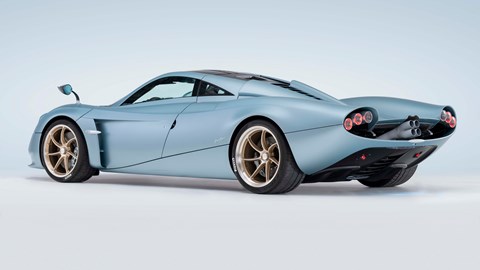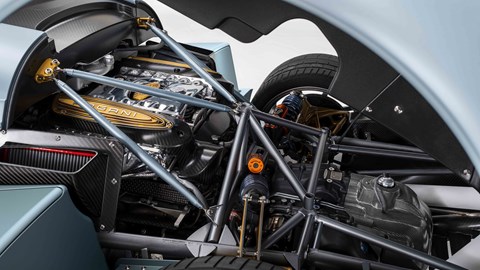► Exclusive long-tail Huayra revealed
► Created by Pagani Grandi Complicazioni
► 829hp, 809lb ft, collaborative design
Ah, we haven’t heard anything from Pagani for a while, have we? So here we are with another round of sold-out limited editions – but instead of keeping the Zonda alive, this time we’ve got an ultra-exclusive version of the Huayra. Called the Huayra Codalunga, it’s Pagani’s take on a long-tail model.
Designed in collaboration with a couple of loyal customers, just five examples will be built. But before you get over-excited about that extended rear end and start reaching for the Amex Black, we weren’t joking about the sold-out part. Each Pagani Huayra Codalunga is spoken for already.
So why are you even mentioning it?
Well, because this is the kind of car that’s just bound to turn up at future concourse events – in fact, judging by the press release that’s pretty much the thinking behind the project.
But it’s also worth your time just to stare at it for a bit. Influenced by the long-tail racing cars of the 1960s, rather than simply lengthen the standard Huayra, part of the process has been to simplify and reduce the complexity of the lines and shapes.

According to Horacio Pagani himself: ‘We made the Huayra Codalunga longer and smoother, as if it had been caressed and molded by the wind, to design lines that were even more elegant than the coupe.
‘The Huayra Codalunga comprises very few essential elements; we have taken away rather than added. Simplifying is not at all straightforward, and this vehicle is, above all, the result of a complex pursuit of simple ideas.’
Make what you will of that last bit, but it’s certainly an arresting-looking machine – if perhaps arguably also appearing a little too like two separate conceptual ideas that have been merged, the result of a DALL-E experiment, perhaps.
From the side it reminds us of the Saleen S7, and in part the outrageous Ford GT90 concept. From the rear it’s more overtly 60s racer curves, while the front is all Huayra. A weird but intriguing mix, and presumably one that’s wholly satisfying to the clients.
How involved were the buyers?
Pagani suggests very. It apparently took two years to finalise the design, including the creation of a 1:4-scale and then a full-size model.
There is a lot of reference to the coachbuilding traditions of the 1960s as well, translated into 2022 by Pagani’s ‘Grandi Complicazioni’ special projects department – which has an even cooler name than Porsche’s equivalent Sonderwunsch (‘special wish’) programme.

We can’t resist including this section of the press release: ‘In line with the Pagani philosophy, the Huayra Codalunga was designed down to the smallest detail in accordance with the creative principles of the great polymath Leonardo da Vinci, an inexhaustible source of inspiration, according to which Art and Science can exist in perfect harmony.’
Emphasising this, we guess, the cars are finished ‘neutral’ colours, with matte or semi-matte paint that also features on the inside. Structural elements are shown in exposed carbonfibre, with ‘artisan touches’ including aged woven suede leathers and aluminium parts that are machined from solid.
As for the coachbuilding, Pagani notes that where in the past it would have all been hand-beaten aluminium panels, the Codalunga uses the firm’s gamechanging composites experience. It also casually notes that the rear engine cover is a single piece with an area greater than 3.7m2.

The exhaust, meanwhile, is titanium, ceramic coated in another homage to those 1960s racing cars. It weighs just 4.4kg, and becomes a bigger focus of attention here due to the Codalunga’s lack of rear grilles.
Is this all just for show then?
While you probably won’t see one of these parked outside the local Aldi, this is very much a working project.
In fact, Pagani says the cars can be certified for road-use globally – including the US market, which can be finickity about this sort of thing.
There are no performance figures given, but not only is the Pagani V12 in the back ‘capable of developing’ 829bhp and 809lb ft, the process of taking stuff away that’s said to define the visual design has also resulted in a 1,280kg kerbweight.
For reference, that’s nearly 200kg less than the Lotus Emira V6.
Check out the hilariously cute official YouTube video of the Pagani Huayra Codalunga below: